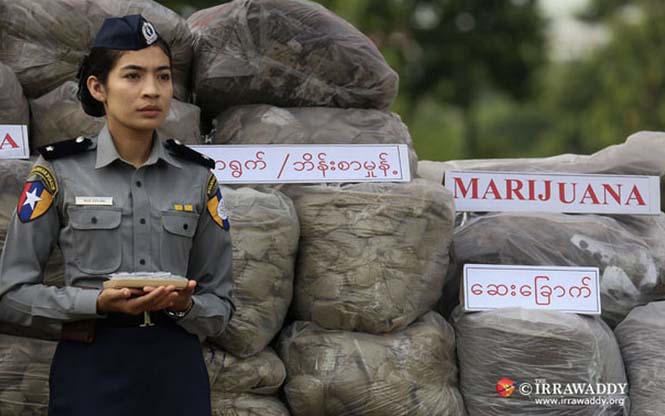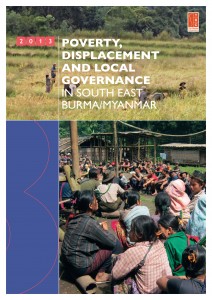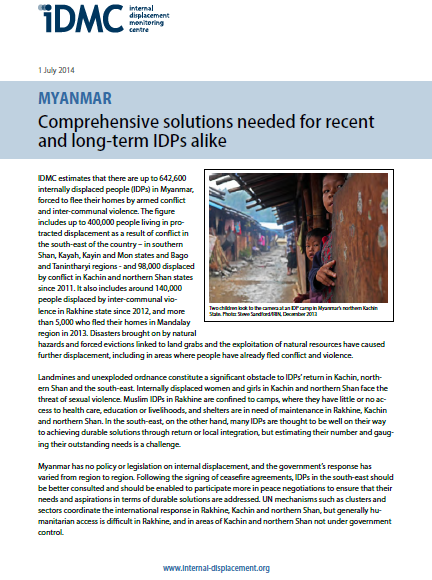Posts Tagged ‘Displacement’ (110 found)
Myanmar: Comprehensive Solutions Needed for Recent and Long-term IDPs Alike
IDMC estimates that there are up to 642,600 internally displaced people (IDPs) in Myanmar, forced to flee their homes by armed conflict and inter-communal violence. The figure includes up to 400,000 people living in protracted displacement as a result of conflict in the south-east of the country – in southern Shan, Kayah, Kayin and Mon states and Bago and Tanintharyi regions – and 98,000 displaced by conflict in Kachin and northern Shan states since 2011. It also includes around 140,000 people displaced by inter-communal violence in Rakhine state since 2012, and more than 5,000 who fled their homes in Mandalay region in 2013. Disasters brought on by natural hazards and forced evictions linked to land grabs and the exploitation of natural resources have caused further displacement, including in areas where people have already fled conflict and violence.
Landmines and unexploded ordnance constitute a significant obstacle to IDPs’ return in Kachin, northern Shan and the south-east. Internally displaced women and girls in Kachin and northern Shan face the threat of sexual violence. Muslim IDPs in Rakhine are confined to camps, where they have little or no access to health care, education or livelihoods, and shelters are in need of maintenance in Rakhine, Kachin and northern Shan […]
• • •Another Great year for Burma’s Drug Trade
 It is of no surprise that the latest report from the UN’s Office for Drugs and Crime (UNODC) on synthetic drugs finds that methamphetamine production in Burma continues to rise. Burma is already the second highest producer of opium in the world after Afghanistan and the fact that production rates of both opium and methamphetamine are increasing year on year points to a more complex picture than simply increase in demand. Poverty, displacement, conflict, and government complicity are all factors in this miserable state of affairs.
It is of no surprise that the latest report from the UN’s Office for Drugs and Crime (UNODC) on synthetic drugs finds that methamphetamine production in Burma continues to rise. Burma is already the second highest producer of opium in the world after Afghanistan and the fact that production rates of both opium and methamphetamine are increasing year on year points to a more complex picture than simply increase in demand. Poverty, displacement, conflict, and government complicity are all factors in this miserable state of affairs.
According to the UNODC report, “2014 Global Synthetic Drugs Assessment – Amphetamine-type Stimulants and New Psychoactive Substances,” that was released in Tokyo, Japan on 20 May 2014, seizures of methamphetamine in Asia have tripled over the past five years. The report highlights how most of the methamphetamine seized in Thailand, Bangladesh, and Burma itself, originates in Burma, while Jason Eligh, country manager for UNODC Burma states that, “according to expert perception, a large share of methamphetamine pills seized in China in 2012 originated from Myanmar.” This report complements a UNODC report on opium production in Burma released six months ago that showed a 26% increase from the year before, the highest recorded levels since monitoring began in 2002 […]
• • •Villagers in Eastern Shan State Suffer Forced Labour and Extortion by Burma Army Troops Guarding Loggers in Salween Dam Flood Zone
Villagers in Murng Paeng township are being used as forced labour by Burmese government troops giving security to military-linked logging operations above the planned Ta Sang dam on the Salween River. The loggers are clearing out teak forests from the projected flood zone for export to neighbouring countries […]
• • •Poverty, Displacement and Local Governance in South East Burma/Myanmar
 As the pace of reform has slowed in Burma/Myanmar during 2013, the potential for an inclusive political dialogue process to address the causes of conflict has increased. The sustainability of national reconciliation will require sensitivity to the concerns and aspirations of ethnic nationality communities in relation to identity, security and justice. This village-level survey describes the challenge of addressing chronic poverty, protracted displacement and weak governance at the community level in South East Myanmar as part of the conflict transformation process […]
As the pace of reform has slowed in Burma/Myanmar during 2013, the potential for an inclusive political dialogue process to address the causes of conflict has increased. The sustainability of national reconciliation will require sensitivity to the concerns and aspirations of ethnic nationality communities in relation to identity, security and justice. This village-level survey describes the challenge of addressing chronic poverty, protracted displacement and weak governance at the community level in South East Myanmar as part of the conflict transformation process […]
Myanmar Peace Process Must Address Protection Concerns: NGO Report
Village Survey in Myanmar identifies challenges for poverty alleviation, displaced persons and local governance
The Border Consortium (TBC), an NGO that works with the displaced and conflict-affected people of Myanmar, today released findings from its annual survey which describe chronic poverty, protracted displacement and weak governance as the starting point for conflict transformation. Eleven civil society organisations in South East Myanmar collaborated with TBC to conduct the survey in 209 villages spread across 6 states and regions […]
• • •Losing Ground: Land Conflicts and Collective Action in Eastern Myanmar
Analysis of KHRG’s field information gathered between January 2011 and November 2012 in seven geographic research areas in eastern Myanmar indicates that natural resource extraction and development projects undertaken or facilitated by civil and military State authorities […]
• • •World Must Act to End Burmese Military Aggression Against Kachin
A new report by the Kachin Women’s Association Thailand (KWAT) details widespread civilian casualties from recent Burma Army offensives in Kachin areas and urges international pressure to end military aggression against the Kachin people […]
• • •State Terror in the Kachin Hills
In late 2012, the Burma Army intensified military operations against strongholds of the Kachin Independence Army (KIA). This culminated in a massive offensive on the KIA headquarters at Laiza on the China-Burma border starting in mid-December […]
• • •Burma: Continued Violence in Rakhine and Persecution of Rohingyas Strongly Condemned
FORUM-ASIA strongly urged the government of Burma to immediately put an end to the violence and to allow humanitarian agencies access to the area. The regional human rights NGO also called on the government of Burma to repeal the 1982 Citizenship Law […]
• • •Letter to President Obama Regarding His Trip to Burma
Dear President Obama: We, the undersigned NGOs, are writing to express our grave concern regarding continuing abuses against ethnic groups in Burma and the implications of your planned trip. By going under current circumstances, you take on a lot of responsibility […]
• • •









 All posts
All posts